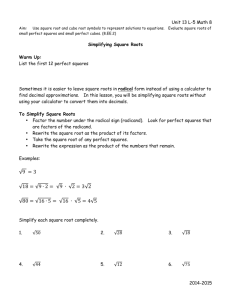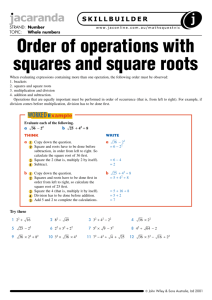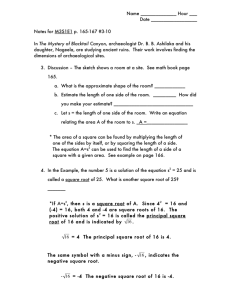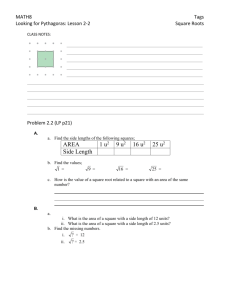File
advertisement
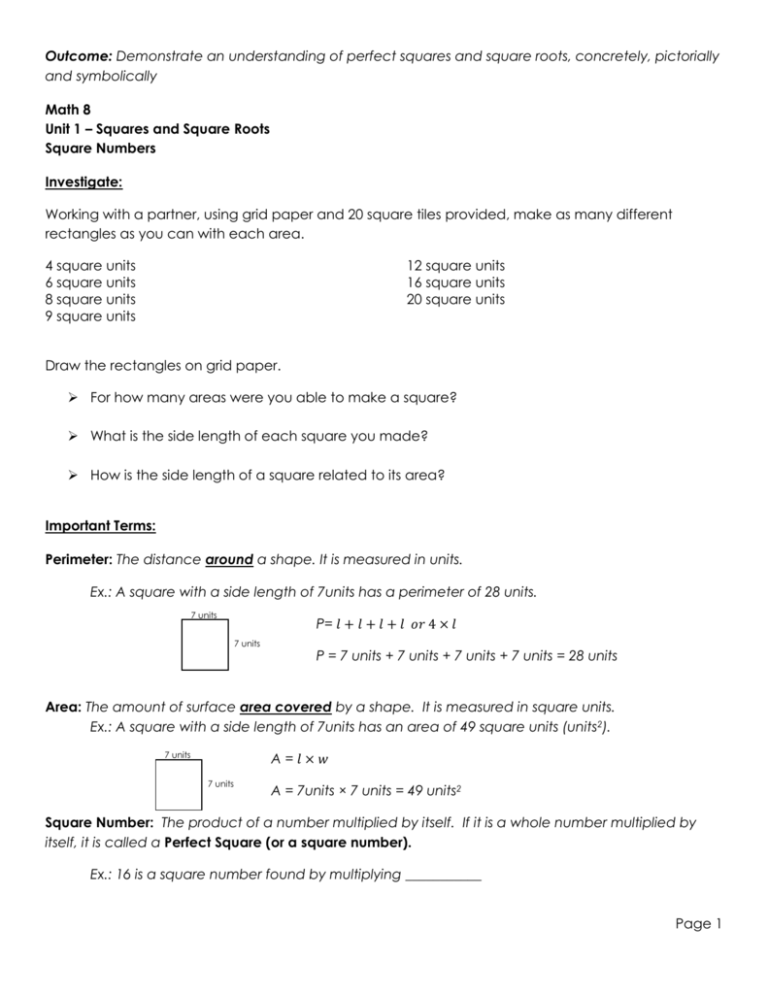
Outcome: Demonstrate an understanding of perfect squares and square roots, concretely, pictorially and symbolically Math 8 Unit 1 – Squares and Square Roots Square Numbers Investigate: Working with a partner, using grid paper and 20 square tiles provided, make as many different rectangles as you can with each area. 4 square units 6 square units 8 square units 9 square units 12 square units 16 square units 20 square units Draw the rectangles on grid paper. For how many areas were you able to make a square? What is the side length of each square you made? How is the side length of a square related to its area? Important Terms: Perimeter: The distance around a shape. It is measured in units. Ex.: A square with a side length of 7units has a perimeter of 28 units. 7 units P= 𝑙 + 𝑙 + 𝑙 + 𝑙 𝑜𝑟 4 × 𝑙 7 units P = 7 units + 7 units + 7 units + 7 units = 28 units Area: The amount of surface area covered by a shape. It is measured in square units. Ex.: A square with a side length of 7units has an area of 49 square units (units2). A=𝑙×𝑤 7 units 7 units A = 7units × 7 units = 49 units2 Square Number: The product of a number multiplied by itself. If it is a whole number multiplied by itself, it is called a Perfect Square (or a square number). Ex.: 16 is a square number found by multiplying ___________ Page 1 Square: The term square means to multiply a number by itself. Ex.: the square of 5 is _____________ Area Model: A model used to determine if a number is square. Ex.: 16 is a square number because all side lengths are the same. 12 is not a square number because not all side lengths are the same. EXAMPLES: 1. Use an area model to determine if the following are square numbers: a. 9 b. 14 c. 20 d. 36 2. Use a diagram, symbols and words to show that 400 is a square number. 3. Find the square of the following: a. 2 b. 5 c. 8 d. 12 Page 2 Your Assignment – Practice Problems: 1. Use a diagram to show that each number below is a square number. a. 1 c. 121 b. 144 d. 900 2. Show that 25 is a square number. Use a diagram, symbols, and words. 3. Which of these numbers is a perfect square? How do you know? a. 10 b. 50 c. 81 d. 20 4. Use 1-cm grid paper. Draw as many different rectangles as you can with an area of 64 cm2. Find the base and height of each rectangle. Record the results in the following table. Base (cm) Height (cm) Perimeter (cm) a. Which rectangle has the least perimeter? b. What can you say about this rectangle? 5. I am a square number. The sum of my digits is 9. What square number might I be? Page 3 Math 8 Unit 1 – Squares and Square Roots Squares and Square Roots Square Numbers Factoring numbers can be used to determine a perfect square. A factor is a number that divides exactly into another number. Ex. 1, 2, 3, and 6 are the factors of 6. What are the factors of 16? An odd number of factors indicates that the number is a perfect square. This is because For example: Since 6 has 4 factors (an even number of factors) it is not a perfect square. Since 16 has 5 factors (an odd number of factors) it is a perfect square. To square a number means to multiply the number by itself. Example: To square 4 means ______________ This can be expressed in exponential form: 42 This is the exponent. It tells you how many times you multiply the base. This is the base. It is the number that is repeatedly multiplied. 42 means _____________ What does 52 mean? ___________________ Page 4 Using your calculator, locate the exponent or square button. Different calculators will work in different ways. Record the procedure for your calculator in this box: Try these using a calculator: 53 = 25 = 52 = You should know the squares of 1 to 15. (This will be important when we start estimating.) 12 22 32 42 52 62 72 82 92 102 112 122 132 142 152 1 4 9 16 25 36 49 64 81 100 121 144 169 196 225 Square Roots A square root is the opposite of squaring. It is the number value for the identical set of factors that are multiplied together to make the square product. The square root is the length of the side of a square. Example: 16 is a perfect square. It is a product of 4 × 4. The square root of 16 is 4. This symbol represents the square root operation: √ , so √25 = 5 Try these: √16 √81 √225 Page 5 Using your calculator, locate the square root button. Different calculators will work in different ways. Record the procedure for your calculator in this box: Try these using a calculator: √256 √729 √6561 √1936 √784 Practice with Squares and Square Roots #1 1. Find the area of a square with each side length: a. 8 units b. 10 units c. 3 units 2. Use square tiles. Make as many different rectangles as you can with area 36 square units. Draw your rectangles on grid paper. Is 36 a perfect square? Justify your answer. 3. Use square tiles. Make as many different rectangles as you can with area 28 square units. Draw your rectangles on grid paper. Is 28 a perfect square? Justify your answer. 4. Find the square of each number. a. 4 b. 6 c. 2 d. 9 c. 12 d. 72 c. 64 d. 169 5. Solve. a. 82 b. 32 6. Find a square root of each number. a. 25 b. 81 Page 6 7. Complete the following questions using your calculator and patterning. a. Find the square of each number i. 1 ii. 10 iii. 100 iv. 1000 b. Determine the pattern for squaring the numbers in part a. (*Hint: look at the number of zeros!) c. Test your pattern by predicting the square of without a calculator, then check with a calculator. i. 10 000 ii. 1 000 000 d. Was your pattern correct? 8. List the factors of each number in ascending order. Determine if each is a square number. If it is a square number, determine the square root. a. 256 b. 625 c. 96 d. 441 e. 152 f. 80 9. Find each square root: a. √1 b. √49 c. √144 d. √9 e. √16 f. √100 g. √625 h. √225 10. Find a square root of each number: a. 32 b. 62 c. 102 d. 1172 Page 7 11. Find the square of each number: a. √4 b. √121 c. √225 d. √676 Practice with Squares and Square Roots #2 Section 1 – Complete each of the following questions without the use of a calculator. Show work, where applicable. 1. 2. Complete the following table: 12= √4 22= √196 32= √16 42= √144 52= √121 62= √36 72= √25 82= √100 92= √81 102= √225 112= √49 122= √169 132= √64 142= √9 152= √1 Show that 36 is a square number. Use a diagram, symbols and words. 3. What is the side length of a square with an area of: a. 100m2 b. 225m2 c. 196m2 4. Which of the following numbers is a perfect square? Support your answer with an explanation. a. 25 b. 121 c. 50 Page 8 5. Find the square of each number. a. 7 b. 12 c. 15 d. 9 6. Determine the product. a. 42 112 c. 132 d. 102 d. 121 b. 7. A square number has 7 factors. Is it a square number? Explain. 8. Determine the square root of each number. a. 9 b. 16 c. 169 9. Solve. a. √225 b. c. √81 d. √144 √196 10. Solve. a. √52 b. √142 c. √2872 11. A square garden has an area of 196m2. It is divided into four congruent square plots. a. What is the area of each plot? b. What is the side length of each smaller square plot? c. What is the side length of the whole square garden area? Section 2 – Complete the following with the use of a calculator. (If rounding is necessary, round to the nearest thousandth – 3 decimal places) 12. Determine the square root of: a. 3136 b. 9604 c. 576 13. Solve. a. √7921 b. √324 c. √961 d. √89 e. √165 f. √209 Page 9 14. Find the square of: a. 82 b. 23 c. 109 b. 192 c. 9022 15. Solve. a. 562 Practice with Squares and Square Roots #3 1. Find the square root of each number. a. 4 b. 16 c. 100 d. 9 2. List the factors of each number is ascending order, then find a square root for each number. a. 225 b. 529 c. 144 3. Evaluate. a. √4 b. Find the square of 4 c. 62 d. Find the square root of 100 4. What is the square root of 32? Explain. Page 10 5. What is the square of √16. Explain. 6. Use a diagram, symbols and words to illustrate the square root of 25. 7. The floor of a large square room has an area of 144m2. a. Find the length of a side of the room. b. How much baseboard is needed to go around the room? What assumptions did you make? c. Each piece of baseboard is 2.5m long. How many pieces of baseboard are needed? 8. A garden has an area of 400m2. The garden is divided into 16 congruent square plots. Sketch a diagram of the garden. What is the side length of each plot? 9. Lee is planning to fence a square kennel for her dog. The area must be less than 60m2, and fencing panels are sold in 1m sections. a. What is the kennel’s greatest possible area? Explain. b. Find the side length of the kennel. c. How much fencing is needed? d. One meter of fencing costs $10.00. i. What is the cost of the fencing? ii. What assumption did you make? Page 11 Outcome: Determine the approximate square root of numbers that are not perfect squares. Math 8 Unit 1 – Squares and Square Roots Practice with Benchmarks Benchmarks are familiar values that are used as points of reference. We will use perfect squares and their square roots as benchmarks when we start estimating square roots. Your Assignment: For each of the following values, identify the two perfect square values that it exists between, then identify which one it is closer to. Since this is practice for estimating, no calculators are permitted. Example: 12 – It sits between the perfect squares 9 and 16. It is closer to 9. 1. 29 2. 108 3. 37 4. 202 5. 95 6. 73 7. 90 8. 7 9. 23 10. 172 Page 12 Math 8 Unit 1 – Squares and Square Roots Estimating Square Roots You will need to be able to estimate the square root of numbers that are NOT perfect square numbers. To do this, you will need to use benchmarks and number lines. Remember… benchmarks are points of reference. For example: o 16 is a perfect square. It is represented by drawing a 4 x 4 square with an area of 16. √16 = 4 (side length of the square is 4) o 25 is a perfect square. It is represented by drawing a 5 x 5 square with an area of 25. √25 = 5 (side length of the square is 5) o There are no perfect square values between 16 and 25, but 20 is a non-perfect square value that sits between them. o Because an area of 20 is between the areas of 16 and 25, you would need to have a side length between 4 and 5 to make an area of 20. √20 = between 4 and 5, but you need to ESTIMATE. Page 13 Estimating Non-Perfect Square Roots Using a Number Line Example: Estimate the value of √20 1. Identify the two perfect squares that the value sits between. benchmark 16 20 25 benchmark In this case, √𝟐𝟎 is between √𝟏𝟔 and √𝟐𝟓 2. Create a number line from the lower perfect square to the higher perfect square. In this example, you would create a number line from √𝟏𝟔 and √𝟐𝟓. 3. Identify the value on the number line. In this case, √𝟐𝟎 4. Identify the square root of the two perfect squares that the value sits between. Make sure to identify these with the perfect squares on the number line. Your estimate will sit between the square root values. In this case, 4 would correspond with √𝟏𝟔 and 5 would correspond with √𝟐𝟓. This means your value will sit between the square roots of 16 and 25, which means that your estimate for √𝟐𝟎 will be between 4 and 5. 5. Identify significant points between the two perfect square values, like the halfway point between them, the quarter and three quarter points between them, etc. 6. Use these points of reference to determine the estimate to one decimal place. If it seems like it is between two values, use two decimal places. Your Number Line for √𝟐𝟎: Means approximately equal to √20 ≅ 4.45 Page 14 Identify the benchmarks that each of the following values sits between: √2 √5 √11 √18 √24 √56 √175 √200 Estimate √13 Work with a partner to estimate square roots of numbers that are not perfect. Use number lines (and grid paper if it helps). Write each estimated square root as a decimal. √3, √5 , √11, √18, √24 Place all your estimates on this number line: Page 15 Try these: √70 √29 Practice Estimating Square Roots #1 1. Between which two consecutive whole numbers is each square root? a. √6 b. √13 c. √57 d. √38 e. √171 f. √115 2. Draw a large sized number line from 3 to 8 (OR draw four separate number lines). Put a “tick” to show every tenth (0.1) on the line. Place each square rot on the number line to show its’ approximate value. You may need to complete this on a separate sheet of paper. a. √11 b. √40 c. √30 d. √55 Page 16 3. In each pair, is the given whole number greater than, less than, or equal to the square root? Justify your answer. a. 7, √14 b. 8, √60 c. 11, √121 d. 12, √150 4. Which whole number is each square root closest to? How did you know? Explain. a. √58 b. √70 c. √90 d. √151 5. Find the approximate side length of the square with each area using a number line. Give each answer to one decimal place. a. Estimate. i. 92cm2 ii. 29m2 iii. 150cm2 b. Calculate the side length with a calculator. Record your answer to the nearest tenth. Page 17 Practice Estimating Square Roots #2 Estimate the square root of each number. Make sure to use a number line and show all benchmarks. When you are done, check your answer with a calculator. 1. 72 Estimate: ___________ Actual: __________ 2. 103 Estimate: ___________ Actual: __________ 3. 55 Estimate: ___________ Actual: __________ Page 18 4. √14 Estimate: ___________ Actual: __________ 5. √86 Estimate: ___________ Actual: __________ 6. √136 Estimate: ___________ Actual: __________ Page 19 Practice Estimating Square Roots #3 1. Estimate each of the following. You need to use a labeled number line with all benchmarks. a. Estimate the square root of 24. b. Estimate √70 2. An unknown number has a square root between 2 and 3. What is one possible value for the unknown number? Explain how you knew. (/2) 3. Determine the square root of the following using a calculator. (/4) a. √62 b. √104 c. √19 d. Explain why the answers in a – c are actually approximations and not exact answers. Page 20 Outcome: Develop and apply the Pythagorean theorem to solve problems. Math 8 Unit 1 – Squares and Square Roots The Pythagorean Theorem A right triangle has two sides that form the right angle (a 90° angle). The two shorter sides of the right triangle (that form the right angle) are called the legs and the longest side (opposite the right angle) is called the hypotenuse. Activity: Developing the Pythagorean Theorem Refer to your “Developing the Pythagorean Theorem” Activity to answer the following question. Write down the relationship you observed between the side lengths of right triangles. Include written, symbolic and pictorial representations. Page 21 The Pythagorean Theorem We can draw squares on each side of the right triangles. Notice that: 25 = 9 + 16 If we call the leg length “a” and “b” and the hypotenuse length “c”, we come up with the general equation: a2 + b2 = c2 In a right triangle, the area of the square on the hypotenuse is equal to the sum of the areas of the squares on the legs. This is called the Pythagorean Theorem. Examples: 1. Find the area of the square on the hypotenuse of the following: 2. Find the area of the square on the leg of the following: Page 22 The Pythagorean theorem can be used to find the length of any side of a right triangle, when we know the lengths of the other two sides. To determine the side length of any side of a right triangle, we must remember: ** Remember: the side length of a square is equal to the square root of the area of the square.** Examples: 1. Find the length of the hypotenuse of the following triangle. Show your work! Find the length of the leg of the following triangle. Show your work! Practice with the Pythagorean Theorem Complete the following questions. Show all work! Page 23 Page 24 Page 25 Page 26 Math 8 Unit 1 – Squares and Square Roots Problem Solving with the Pythagorean Theorem To use the Pythagorean Theorem in problem solving, draw and label a diagram, and then solve. Example #1: A 4m ladder is leaning against the wall of a building. The foot of the ladder is 2m from the base of the building. How far up the wall is the top of the ladder? Example #2: You decide to go for a hike in the country. You travel 15km straight North, then turn and walk 7km straight East. How many kilometers have you walked? If you wanted to walk straight back to your starting position, how far would you have to travel? (Round your answer to the nearest tenth, if necessary). Page 27 Problem Solving with the Pythagorean Theorem 1. A doorway is 2.0 m high and 1.0 m wide. A square piece of plywood has a side length 2.2 m. Can the plywood fit through the door? How do you know? Show your work. Always start a problem by drawing a picture. 2. A ramp is used to load a snow machine onto a trailer. The ramp has a horizontal length of 168 cm and a sloping length of 175 cm. How high is the ramp? 3. 4. Page 28 5. 6. 7. Page 29 Page 30 Page 31 Page 32

